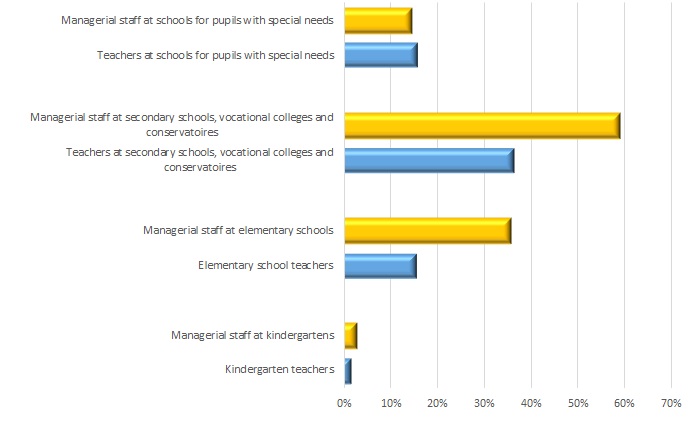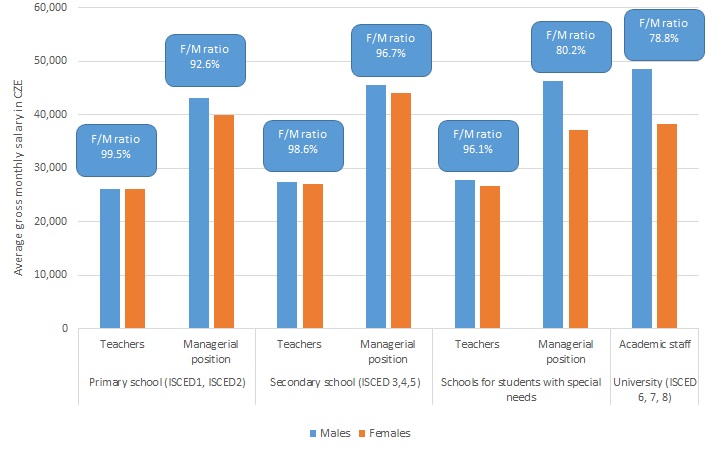The Czech government has introduced several initiatives aimed at decreasing the gender pay gap in the education system which, although small at lower educational levels, increases with career advancement. In the first half of 2015, this gap was 13.5% for management positions, and 21% for academic staff at public universities; the national average gender gap is 22%.
Gender segregation in the educational sector
The education and training sector in the Czech Republic is, on the whole, strongly female-oriented, especially at lower educational levels. In comparison with other OECD countries, the Czech Republic has one of the highest percentages of women working in the lower levels of education. In 2014, the proportion of male kindergarten school teachers was less than 1%, with men accounting for only 14% of the teaching staff in elementary schools – International Standard Classification of Education (ISCED) level 1 and ISCED level 2. This has not changed since 2006 and there are currently no signs that this is likely to change. The secondary school (ISCED level 3) and vocational college (ISCED level 5 and ISCED level 6) sectors are also strongly female-oriented, making up approximately two-thirds of teaching staff.
The situation at public universities is, however, completely different; male teachers vastly outnumber their female counterparts at such institutions and the proportion increases the higher the position on the hierarchical ladder of academic titles and positions. Only 15% of university professors and 36% of associate professors are women; however the proportion of men and women working as professional assistants or aides is more or less balanced at 43% men and 48% of women.
In terms of the imbalance between men and women in management positions, the same pattern applies to lower educational levels. Management positions are occupied more often by men than women in comparison to the overall gender structure of teaching staff, as shown in Figure 1. The biggest difference is between management staff and ordinary teachers at secondary and vocational schools; the presence of men in management positions is 22.6 percentage points higher than ordinary teaching staff. A similar difference (19.9 percentage points) can be seen between the number of male teachers and male managerial staff at elementary school level.
Figure 1: Percentage of male teachers according to level of education and managerial positions (Q1–Q2, 2015)

Source: MŠMT, calculations from ISP data.
Note: Yellow = managerial staff, blue = overall teaching staff
Inadequate evaluation of teachers’ qualifications
The Czech education system provides a typical example of gender segregation and low wages. The feminisation of the Czech education system in comparison with those in other developed countries is above average and the remuneration, relative to qualifications, is below average. The remuneration of Czech teachers is not competitive compared with the salaries paid in other sectors employing a similarly educated workforce. Specialists in education and training are a subgroup of the lowest salaries of any highly skilled workers. In the Czech Republic, the ratio of the salaries of teachers at ISCED level 1 and ISCED level 2 schools, compared with those of workers with a similar educational attainment (working full-time throughout the year) is the lowest of any OECD country. Teachers’ salaries are equivalent to 52% of those earned by other workers with the same educational attainment, while the OECD average is 78% for ISCED level 1 school teachers and 80% for teachers at ISCED level 2 schools.
Due to low remuneration, especially at the elementary school level, and the prevalence of the ‘male-breadwinner, female-carer’ family model favoured by Czech society, it is difficult to motivate men to take up teaching positions. If one considers the education system as a closed reference sector, women focus principally on those levels with the lowest salaries; nurseries and elementary schools. Conversely, men are beginning to be more strongly represented at educational establishments which pay higher salaries, such as secondary schools and universities.
The most recent increase in teachers’ salaries (3.5%) was awarded in November 2015. Changes were also made to the salary tariff structure so as to better reflect length of service. Previously, after 25 years of service, teachers had no further prospect of an increase in salaries. Recently, the new Minister of Education, Kateřina Valachová, highlighted the imbalance between the average wages of university-educated teachers and other university graduates and called for more funding for teachers’ salaries. At the same time, an amendment to the Act on Educational Staff is being prepared which will introduce a new career structure; a requirement for a higher level of accountability on the part of teachers in terms of their further education will be accompanied by an increase in the financial reward for their work.
The gender pay gap at different levels of the education system
In education, as in other professions, low incomes generally reduce overall variability and this means that at certain levels, salary differences between men and women in education are very slight. However, the main reason for the low gender pay gap of teachers in the regional education system is the salary tariff that determines pay for this group. A higher gender pay gap is evident in managerial positions, where remuneration is determined by a number of components and a different mechanism. Overall, the gender pay gap for managerial staff in the education sector stands at 13.5%. The highest average wage difference between men and women was discovered to be 19.8% among managers of schools for pupils with special needs, as shown in Figure 2. In this respect, the education sector mirrors the general trend in the Czech economy where the greatest differences in women’s and men’s pay occur in managerial positions.
Among ordinary teachers, gender pay gaps are no higher than 5%. In general, therefore, compared with the Czech average, gender salary inequality in the education sector is relatively weak. The overall Czech gender pay gap over recent years has hovered at around 22%, and even wider gaps are often found in the private sector.
Figure 2: Differences in salaries by managerial position and school level (2015)

Source: MŠMT, calculations from ISP data.
Note: Data on the regional school system refers to Q1–Q2 of 2015. Data on academic staff cover Q1–Q4, 2015.
At universities, which determine their own salary regulations and do not award salaries according to centrally set salary tariffs, the pay gap between men and women is about the national average. On average, in 2015, women working in the academic sphere at public universities received 79% of the remuneration paid to their male colleagues. Male university professors received approximately 5% higher remuneration than their female counterparts, with associate professors and expert assistants earning around 11% more than women, as shown in Figure 3.
Figure 3: Average monthly salaries of academic staff at public universities (Q1–Q4, 2015)

Source: MŠMT, calculations from ISP data.
Government measures to promote equal pay
The Czech government has introduced a number of initiatives aimed at narrowing the gender pay gap; the Minister of Labour and Social Affairs launching a five-year campaign called ‘22% to fairness’ (22% being the average gender pay gap in the Czech Republic). The most frequently discussed and visible part of the campaign consists of systematic inspections specifically focused on screening and pay discrimination. Specially-trained State Labour Inspectorate experts will be responsible for conducting salary inspections.
Conclusions
Compared with other developed OECD countries, the Czech education system is highly female-oriented and has low levels of remuneration. The strong feminisation of the sector goes hand-in-hand with low salaries at lower education levels and almost non-existent salary differences at these levels between men and women, thanks to the salary tariff system.
The problem of wage inequality begins at higher salary levels. A significant gender pay gap (13.5%) is evident among school managerial personnel and public university academic staff (21.2%) where strong feminisation is no longer a factor. Indeed, in the case of universities, the ratio of male and female staff is reversed in favour of men. Thus, government measures aimed at promoting gender pay equality in the education sector will need to focus principally on managerial positions and the university academic sphere.